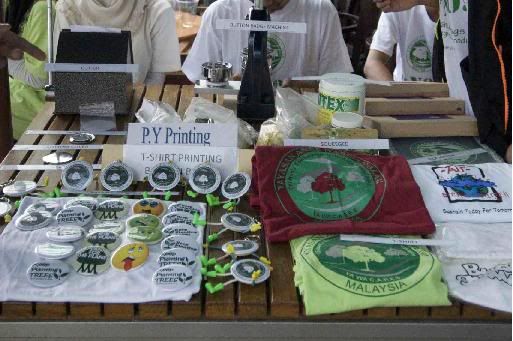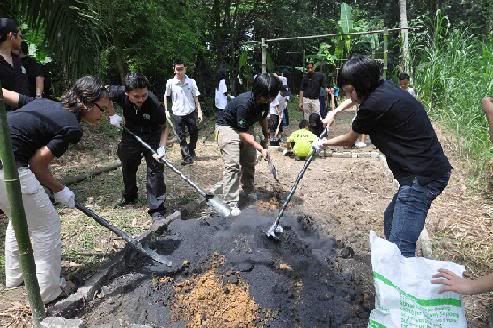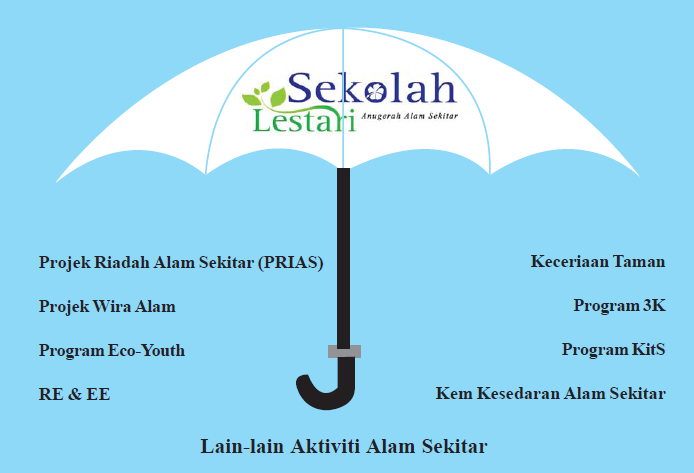Asian Wetland School 1 Network Enchange Program Sandakan
Friday, 27 January 2012 | 0 comments
On the 15th of March 2011, 109 children and youth from the age of 10 to 18 years old gathered in Sandakan, Sabah for the Asian Wetlands School Network Exchange Program. A total of six countries participated which were Japan, China, Bangladesh, Korea, Thailand and Malaysia. The aim of this conference was to establish a Wetland School Network Coordination Committee to make sure to sustainability of the network among wetlands school in the five countries. I was lucky to be apart of this program as a Junior Board.
The program kick started with registration held in Paganakan Dii; an eco-friendly resort where all of the participants stayed. In the evening, participants headed to the Rainforest Discovery Center for dinner, ice-breaking games and a brief introduction to the program. During the introduction of the conference, we watched a 20-min video on the wetlands in Sabah particularly the mangrove swamps known as Lower Kinabatangan Segama Wetland that is the only RAMSAR site in Sabah. This site is home to many endangered species such as the Sumatran Rhinoceros, Proboscis Monkey and the Orangutan.
For teh next three days, we visited a few places, the Sepilok Orang Utan Rehabilitation Center, Rainforest Discovery Center Kg, Batu Puteh anf Kg. Terusan.
Sepilok Orang Utan Rehabilitation Center
Our first fieldtrip was to the Sepilok Orang Utan Rehabilitation Center. We were given the privilege to see for ourselves how the orangutan are taken care and trained at the Sepilok Wildfire Medical Centre. According to Auntie Sylvia the Director of the center, the biggest threat to the orangutan is loss of habitat due to deforestation and urban development. Some areas of the forest are also cut down to make way of palm oil plantation. As a result, the baby orangutan are separated form their mother. Instead they are saved by the plantation workers and handed over to the rehabilitation centre. Other times, rescue teams are sent into the forest to save these orangutan. At the Sepilok Rehabilitation Center, these orphan orangutans are taught how to survival skills such as find food and build nests. After eight years, they are released back into the wild. Auntie Sylvia also mentioned that Orangutan are engineers of the Forest as they make intricate and beautiful nest for themselves. She also emphasized the role of Sabah Forestry Department in conserving the endangered species. The Sabah Forestry Department has reserved 4295 ha of land for these orangutans. Besides that, mandatory jail will be imposed to those who are found guilty of killing orangutans.
Afterwards, we were fortunate to visit the Sun Bear Conservation Center. Wy Pak, the project manager of the Sun Bear Conservation Effort gave us a tour of the center. During the tour, he filled us in on the sun bears. He mentioned Sun Bears are the smallest species of bears. They are knows as sun Bears because they love to sunbath on trees. They have long tongues and different pattern below their necks. They usually sleep in hollow logs or nests on trees. Unfortunately these bears are hunt for their pancreas, which can be used as a traditional medicine and their claws.
Rainforest Discovery Center
On the second day, we took a tour around Rainforest Discovery Center. We covered the botanical garden to the rich rainforest. Some of the plant species that caught our attention were the Liyana that is also known as the highway of the forest and the Venus Fly Trap - a carnivorous plant that only survives after 12 times it snaps. We also saw the tiger orchid that is the largest orchid in the world.
Presentation of The Countries.
On the second night, each country representatives talk about the wetlands in thier respective countries. Some also shared the activities carried out by their organization. In Bangladesh, wetlands are important as means of transport and source of food for the villagers. Wetlands are also important in Japan as it houses more than 25 species of endemic fishes like the Japanese Catfish. Wetlands also play a role as a habitat of the migratory bids. Besides that, the China delegates stressed out its funtion as a filter that filters the seawater into fresh water. At the same time, each country representative shared their effort persevering their own wetlands. In Krabi Island, Thailand, they organize school trips to mangrove sites to raise awareness among school children on the importance of the wetlands. While japan had a creative approach to this matter which is through musical productions. The Cinderella Company is a Musical Production in Japan that produces musical productions based on the wetland environment. On the other hand, the Korean delegates talked about their school project entitled the Extraction of Natural Seaside and Preservation of mudflats.
Kg. Batu Puteh, Sg. Kinabatangan
The participants took a fieldtrip to Kg. Batu Puteh on the third day. We took a tour around the village and to the nurseries. The head village demonstrated how the conservation of wetlands is done. Some of the wetland plants that were planted are Salongpad, Mangkapon and Bongkol. Later, we learned about the culture of the Sg. People. Half of us were taught how to dance and the other half were taught to play the traditional music instruments.
Children Workshop
On the second night, night we took part in a workshop at the EE Activity Hall. Each group had to draw out their experiences for the past two days. We were told the drawings would be presented on the last day. For the second workshop we got into our group according to country. We had to send two representatives from each country to give a speech base on our experiences and feeling throughout the conference. Our speech had to include our experiences, lesson learned and suggestions to stay connected among the Asian Wetlands Countries.
 Our last fieldtrip was to one of the fishing villages along Sg. Kinabatangan. My group visited Kg. Terusan. We were taught how to sew the fishing nets and how to make salted fish. The villagers also taught the delegates how to spread the fishing nets in deep water.
Our last fieldtrip was to one of the fishing villages along Sg. Kinabatangan. My group visited Kg. Terusan. We were taught how to sew the fishing nets and how to make salted fish. The villagers also taught the delegates how to spread the fishing nets in deep water.
The program kick started with registration held in Paganakan Dii; an eco-friendly resort where all of the participants stayed. In the evening, participants headed to the Rainforest Discovery Center for dinner, ice-breaking games and a brief introduction to the program. During the introduction of the conference, we watched a 20-min video on the wetlands in Sabah particularly the mangrove swamps known as Lower Kinabatangan Segama Wetland that is the only RAMSAR site in Sabah. This site is home to many endangered species such as the Sumatran Rhinoceros, Proboscis Monkey and the Orangutan.
For teh next three days, we visited a few places, the Sepilok Orang Utan Rehabilitation Center, Rainforest Discovery Center Kg, Batu Puteh anf Kg. Terusan.
Sepilok Orang Utan Rehabilitation Center
Our first fieldtrip was to the Sepilok Orang Utan Rehabilitation Center. We were given the privilege to see for ourselves how the orangutan are taken care and trained at the Sepilok Wildfire Medical Centre. According to Auntie Sylvia the Director of the center, the biggest threat to the orangutan is loss of habitat due to deforestation and urban development. Some areas of the forest are also cut down to make way of palm oil plantation. As a result, the baby orangutan are separated form their mother. Instead they are saved by the plantation workers and handed over to the rehabilitation centre. Other times, rescue teams are sent into the forest to save these orangutan. At the Sepilok Rehabilitation Center, these orphan orangutans are taught how to survival skills such as find food and build nests. After eight years, they are released back into the wild. Auntie Sylvia also mentioned that Orangutan are engineers of the Forest as they make intricate and beautiful nest for themselves. She also emphasized the role of Sabah Forestry Department in conserving the endangered species. The Sabah Forestry Department has reserved 4295 ha of land for these orangutans. Besides that, mandatory jail will be imposed to those who are found guilty of killing orangutans.
Afterwards, we were fortunate to visit the Sun Bear Conservation Center. Wy Pak, the project manager of the Sun Bear Conservation Effort gave us a tour of the center. During the tour, he filled us in on the sun bears. He mentioned Sun Bears are the smallest species of bears. They are knows as sun Bears because they love to sunbath on trees. They have long tongues and different pattern below their necks. They usually sleep in hollow logs or nests on trees. Unfortunately these bears are hunt for their pancreas, which can be used as a traditional medicine and their claws.
Rainforest Discovery Center
On the second day, we took a tour around Rainforest Discovery Center. We covered the botanical garden to the rich rainforest. Some of the plant species that caught our attention were the Liyana that is also known as the highway of the forest and the Venus Fly Trap - a carnivorous plant that only survives after 12 times it snaps. We also saw the tiger orchid that is the largest orchid in the world.
Presentation of The Countries.
On the second night, each country representatives talk about the wetlands in thier respective countries. Some also shared the activities carried out by their organization. In Bangladesh, wetlands are important as means of transport and source of food for the villagers. Wetlands are also important in Japan as it houses more than 25 species of endemic fishes like the Japanese Catfish. Wetlands also play a role as a habitat of the migratory bids. Besides that, the China delegates stressed out its funtion as a filter that filters the seawater into fresh water. At the same time, each country representative shared their effort persevering their own wetlands. In Krabi Island, Thailand, they organize school trips to mangrove sites to raise awareness among school children on the importance of the wetlands. While japan had a creative approach to this matter which is through musical productions. The Cinderella Company is a Musical Production in Japan that produces musical productions based on the wetland environment. On the other hand, the Korean delegates talked about their school project entitled the Extraction of Natural Seaside and Preservation of mudflats.
Kg. Batu Puteh, Sg. Kinabatangan
The participants took a fieldtrip to Kg. Batu Puteh on the third day. We took a tour around the village and to the nurseries. The head village demonstrated how the conservation of wetlands is done. Some of the wetland plants that were planted are Salongpad, Mangkapon and Bongkol. Later, we learned about the culture of the Sg. People. Half of us were taught how to dance and the other half were taught to play the traditional music instruments.
Children Workshop
On the second night, night we took part in a workshop at the EE Activity Hall. Each group had to draw out their experiences for the past two days. We were told the drawings would be presented on the last day. For the second workshop we got into our group according to country. We had to send two representatives from each country to give a speech base on our experiences and feeling throughout the conference. Our speech had to include our experiences, lesson learned and suggestions to stay connected among the Asian Wetlands Countries.
Kg. Terusan
 Our last fieldtrip was to one of the fishing villages along Sg. Kinabatangan. My group visited Kg. Terusan. We were taught how to sew the fishing nets and how to make salted fish. The villagers also taught the delegates how to spread the fishing nets in deep water.
Our last fieldtrip was to one of the fishing villages along Sg. Kinabatangan. My group visited Kg. Terusan. We were taught how to sew the fishing nets and how to make salted fish. The villagers also taught the delegates how to spread the fishing nets in deep water. In conclusion the conference has bought a lot of benefits. Besides gaining more knowledge on the wetlands in Sabah, participants have also learned more on the wetlands in other countries. Simultaneously, participants were given a chance to see the mangrove swamps up close. Through this conference too, participants had the opportunity to exchange ideas on ways to conserve the wetlands. (Anisa Yasmin Bt Fadhil Hassan Ismail Yassin)











